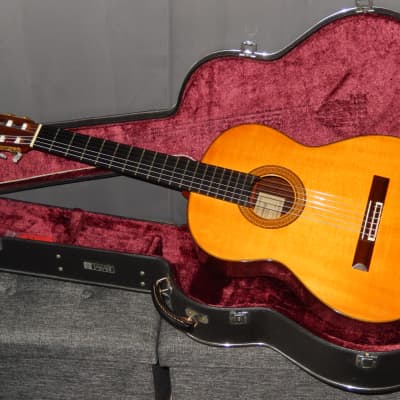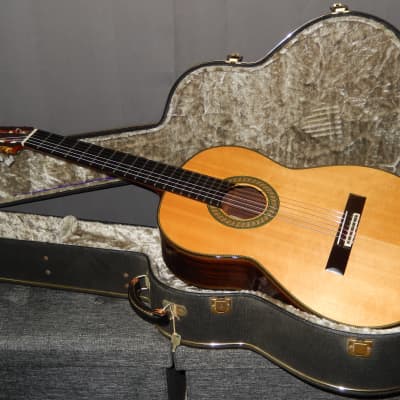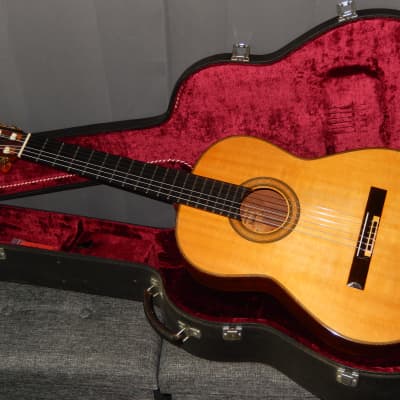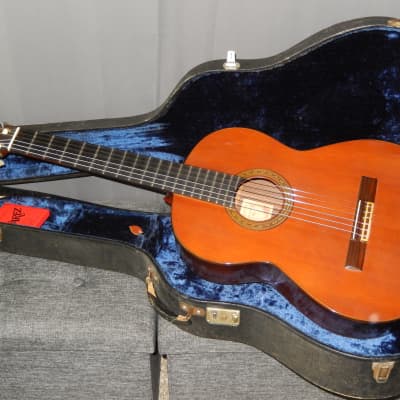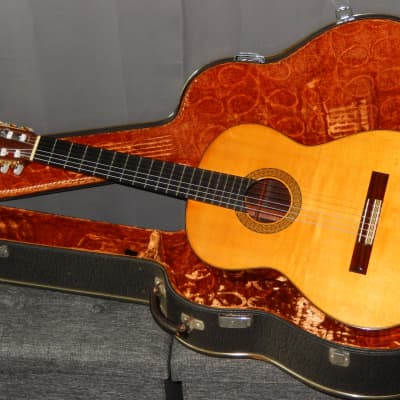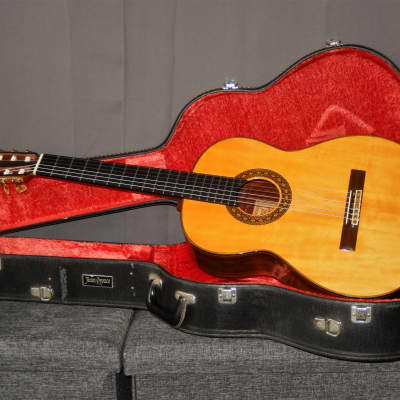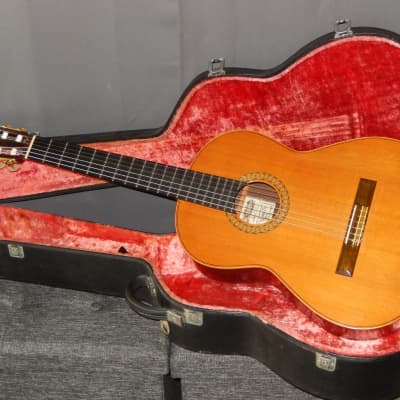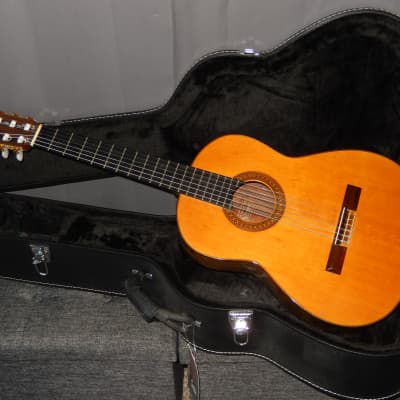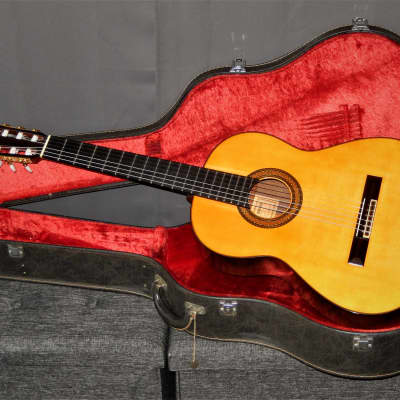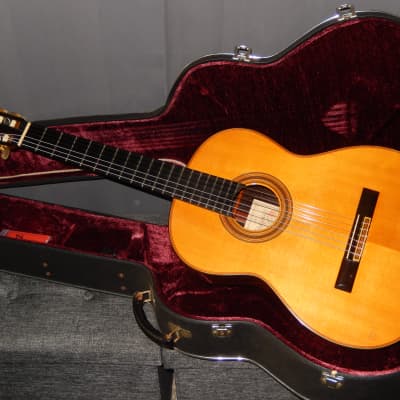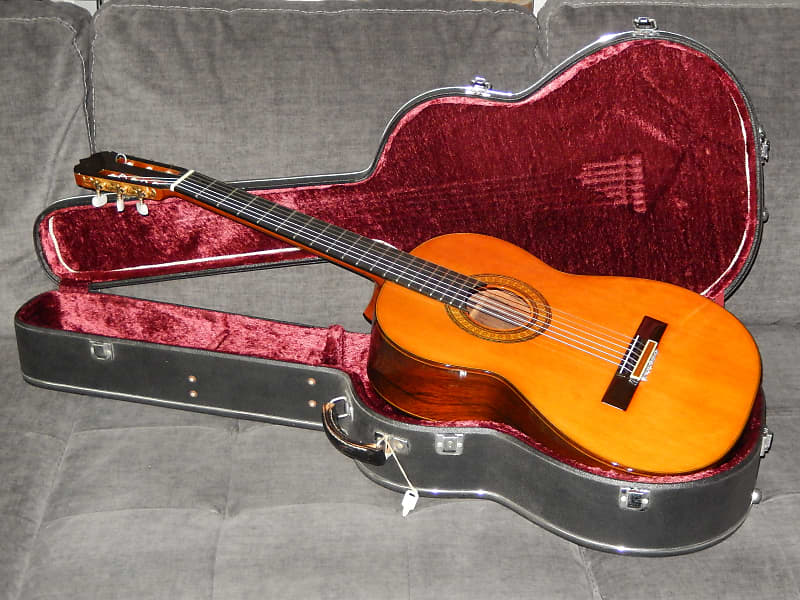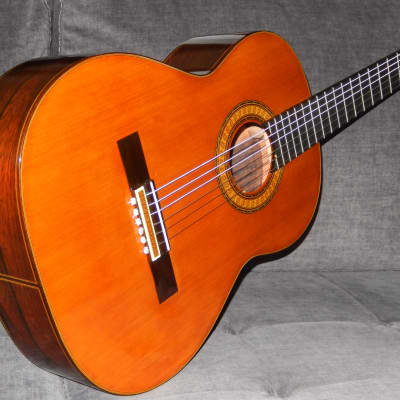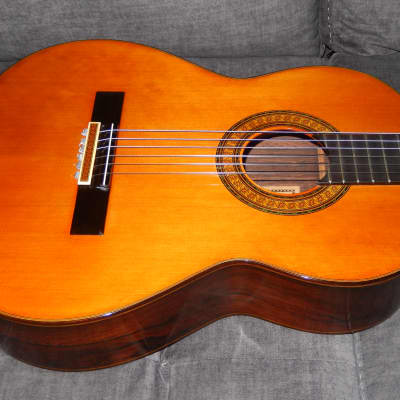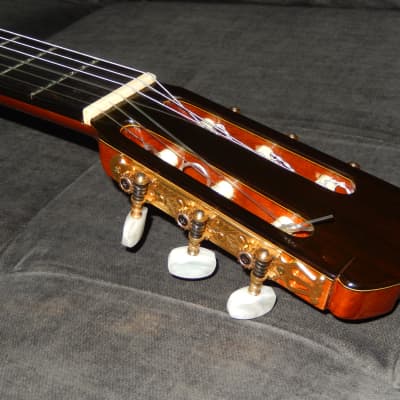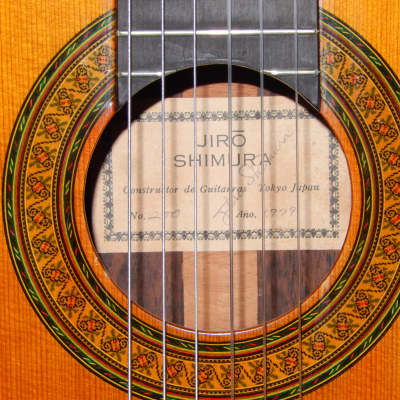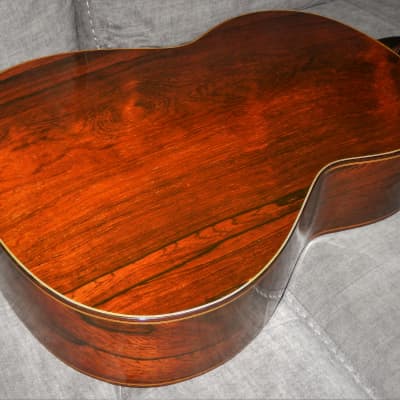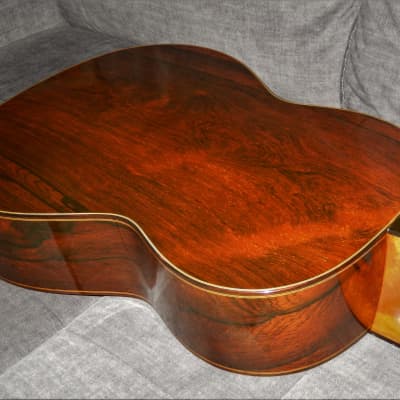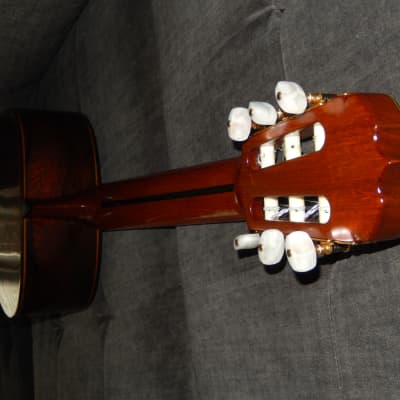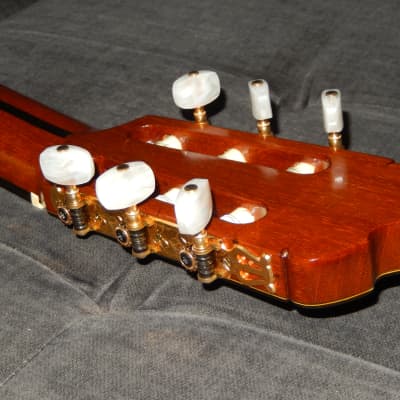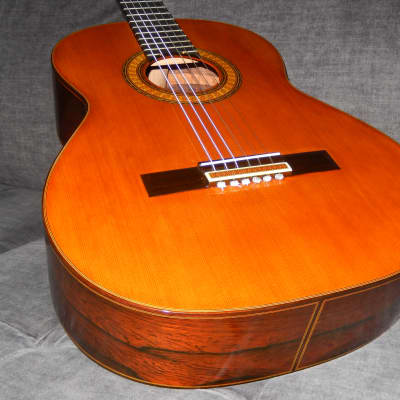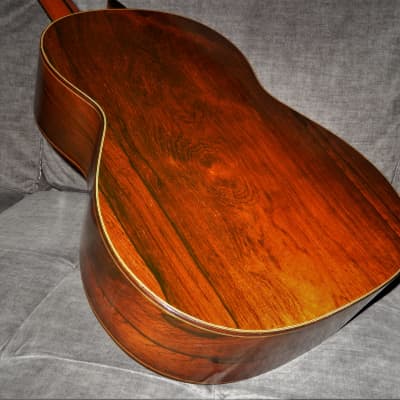An important message for Australian buyers is located at very bottom of this page.
Jiro Shimura No 200 1979
Jiro Shimura was one of many highly skilled Japanese luthiers, totally unknown in the West. There is very little chance to find any precise info about this craftsman. Besides this (posted for sale) guitar, I have only seen few more of his guitars, within last 7 years.
This guitar was priced 200 000 yen in 1979 being very expensive instrument.
During the same 1979, guitars priced 200 000 yen made by Japanese elite luthiers (like Masaru Kohno, Sakazo Nakade or Yamaha) all had solid Brazilian Rosewood b/s. It is obvious then, that a little known, not prominent luthier trying to sell his instrument at such price, had to offer something quite special.
Instrument of similar class (the same construction, the same woods aged for at least 40 years) made today in Japan would cost you minimum $5000USD.
Although it doesn't have traditional Spanish heel body/neck joint, this guitar has been made basing on blueprints used by Casa Ramirez in 1960s. It also has very similar to old Ramirez 1a volume and tonality. It was made with medium thick solid Cedar top, solid BR sides and double back (2 plates of BR not glued together). The outer back plate is made from one piece of wood on the outside, while the inner plate is made from 2 book matched halves on the inside. Because the body of this is guitar is very light, I am sure that both back plates are “non-solid”. Perhaps the best term to describe their nature is “semi-solid”. They are nothing but 2 very thin plates of solid wood glued together. The finish on this guitar is very thin, very similar to shellac.
This construction always leads to incredible volume. So is the case with this guitar. Even if played gently its volume is high, while if played harder it changes to immense. Basses are very deep, while trebles thick and round, which closely resemble tonality of vintage Ramirez guitars. This makes this guitar quite different from majority of Japanese guitars of that era.
The overall condition can be described as “excellent for its age”. There are no conspicuous scratches or dents on the body of this guitar, perhaps the most noticeable is small attrition at the edge of sound hole right below string E1. The most important to mention detail is that its bridge had to be sanded down in order to lower the original action, which was around 5.50mm on the bass side. In this respect, Jiro came too close to original Ramirez 1a guitars. After this “modification” this guitar is far more comfortable to play than it originally was.
Specifications:
Top: High Grade Solid Cedar/ shellac-like finish
Sides: Solid Figured Brazilian Rosewood/ shellac-like finish
Double Back: 2 “semi-solid” plates of Figured Brazilian Rosewood/ shellac-like finish
“Laminated” is quite unfortunate term regarding Japanese made guitars. In recent years guitar makers around the world adopted new term "semisolid" that more precisely describes construction of such plates. These plates were made from 2 layers of solid wood glued together with natural resins. They were made so well that they performed as good as solid woods while being far less expensive in guitar production and far more resistant to cracking in regular use.
Neck: Mahogany
Fingerboard: Ebony
Scale: 650 mm
Nut width: 52 mm
Current action is set to 4.00 mm under E6 and 3.20 mm under E1, without any extra room on the saddle.
Guitar will be shipped in used hard shell case in still very good condition.
When contemporary Japanese luthiers are using 40+ years old soundboards to make “all solid woods” guitar it is priced at least $5000USD. Guitars with artificially aged (“baked”) soundboards are priced at least $4500USD. Solid top models with 40+ years old soundboards are priced at least $3500USD. American, Australian and European luthiers usually charge 50% more.
It is a matter of basic education (not beliefs) to realize that 50+ years old soundboard of this guitar alone is worth $2500USD.
The key to understand value of vintage Japanese guitars is to acknowledge galloping price inflation (devaluation of Japanese yen) during 1960s & 1970s. This inflation slowed down in 1980s.
During 1960s and most of 1970s model numbers of Japanese guitars were strictly interconnected with their prices in Japanese yen. By early 1980s and during following decades model numbers were no longer strictly associated with their prices. Some Japanese guitar makers introduced model names instead of model numbers. Others were still using model numbers with addition of letters and/or other symbols.
It is then important to understand that two Yamaha GC10 guitars made 10 years apart are two instruments of totally different class. The same applies to any other Japanese maker/brand.
The logical way to estimate the true class of any given Japanese made instrument is to compare its price with the average annual salary of wage workers in Japanese private sectors. This salary was: 450 600 yen in 1965 - 825 900 yen in 1970 - 1 868 300 yen in 1975 - 2 689 000 yen in 1980 - 3 163 000 yen in 1985 - 3 761 000 yen in 1990 - 4 107 000 yen in 1995 - 4 082 000 yen in 2000.
Any guitar priced 100 000 yen in 1970 (labelled as No10 or No100) would be priced 200 000 yen in 1975 (relabeled to No20, No200 or 2000), 300 000 yen in 1977 (labelled as No3, No30 or 3000) and 500 000 yen by 1985 (labelled as No50 or 5000).
Starting in 1977 Masaru Kohno introduced his new models No40 priced 400 000 yen and No50 priced 500 000 yen. By early 1980s Kohno started using model names instead of numbers and was steadily raising their prices without changing model labeling. His very top model 50 became model “Special”, and a decade later it became model “Maestro”. Naturally, all other Japanese guitar makers were doing similar pricing (labelling) upgrades.
Knowing all of that, you can bet on that Masaru Kohno No50 made in 1982 is practically the same grade instrument as Kohno No20 made in 1972, or Kohno no 30 made in 1975.
In early 1970s the lowest Ryoji Matsuoka (all plywood) model was 10, followed by (solid top) models 15, 20, 25, 30, 40, 50, 60, 80 and (all solid woods) models 100 and 150. Models 50, 60 and 80 were made with non-solid figured Brazilian Rosewood (double) back and sides and top model 150 was the only one made with solid figured Brazilian Rosewood b/s.
In 1980 the lowest Matsuoka model was (all plywood) 20, followed by (solid top) models 30,40,50, 60 and all solid woods models 80,100,150 and 200. By 1990 the lowest Matsuoka model was M40 and the highest was M300. By 2010 the lowest Matsuoka model was M50 and the top model was M270.
You can bet that Ryoji Matsuoka model 50 from 1980 is of the same grade as model M100 from 2000, model 100 from 1980 is of the same grade as model M150 from 2000, model 150 from 1980 is of the same grade as M200 from 2000 and model 200 from 1980 is of the same grade as model M300 from 2000.
It is important to mention that if modern era luthiers are using 40+ years old woods to make an “all solid” wood classical guitar, its price is minimum $8000.
All vintage guitars made with Brazilian Rosewood are especially precious, including those made straight grain varieties and those with non-solid b/s.
Because response and tonal properties of Spruce soundboards are improving over time, long seasoned Spruces are far more precious than long seasoned Cedars.
It is not very difficult to find out what are current prices of such guitars made by world’s leading luthiers.
Important message for Australian buyers:
USPS International Priority Mail packages destined for Australia have quite restricted size (max. length is 42” and max. length + girth is 97”). For these reasons I must use the case that is no longer than 41” and therefore it may be different than the one you see on the pictures. You should ask me for any other details prior to making a purchase.

